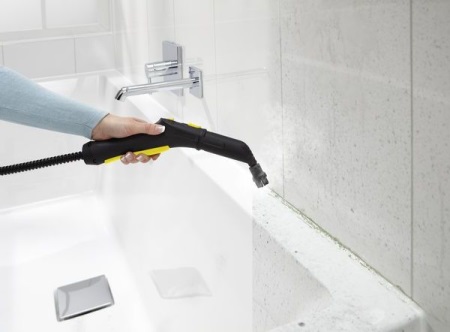How to remove mold in the bathroom on the sealant?

Silicone sealant is indispensable when installing new plumbing equipment in the bathroom, as well as for various types of repair work. The silicone-based sealant perfectly protects surfaces from moisture due to its special composition. The sealant forms a durable and at the same time elastic coating, resistant to temperature changes and aggressive detergents. There are also special sanitary silicone sealants, which contain fungicidal additives that prevent the appearance of mold and mildew - these troubles are quite common in conditions of high humidity. For use in the bathroom, it is recommended to buy this type of sealant.
If it happens that black mold has developed on the surface treated with the sealant, it is necessary to immediately begin to fight it. Read about what measures to take in our article today.
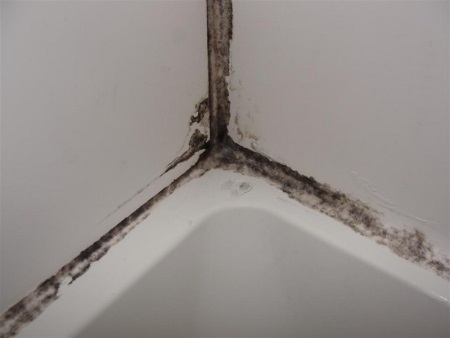
Why does mold appear on the sealant?
The main cause of mold growth on all types of surfaces is excessively humid indoor air. Additional factors contributing to the active growth of mold can be the lack of a good ventilation system, insufficiently insulated walls, poor sealing of joints between panels.
If mold has appeared on a surface that has been treated with silicone sealant containing fungicides, then, most likely, the reason lies in the poor quality of the product. If you used a sealant from a proven manufacturer, in the quality of which you are confident, then you should look for other reasons. For example, mold could have appeared as a result of improperly performed work on sealing the seam, or due to the presence of cracks and chips in the structure of the working surface.
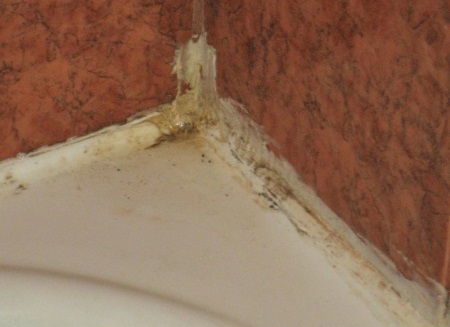
What are the dangers of mold in the bathroom?
Mold is an amazing organism that can both benefit and harm humans. The kind of mold that settles on surfaces in our home is of the latter type. So if you notice the first signs of mold spreading in your home or non-residential space, get rid of it as soon as possible.
Mold is known to spread with the help of spores - microscopic particles that can fly freely around the house, repopulating more and more areas. Even if you manage to get rid of the main nidus of mold, the spores that have spread throughout the apartment can cause new nidus to grow.
The damage that mold does to the human body is not immediately noticeable. The spores that we breathe in with the air can cause fairly serious diseases of the respiratory tract, nasopharynx, digestive system and other vital organs. Allergy sufferers and people with a weakened immune system are at increased risk.
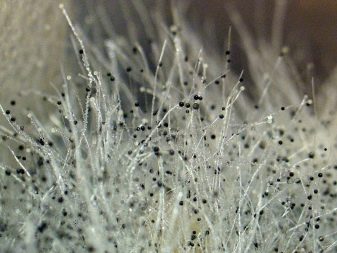
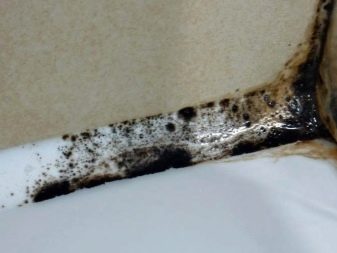
Removing mold from the surface
The way to deal with mold that has appeared on silicone sealant depends on the extent of the problem and how long ago it appeared. A small area of "fresh" mold can simply be washed off and then treated with an antiseptic. If you manage to take action quickly, it is likely that mold will not return. Otherwise, you'll have to resort to a more radical method.
So how do you properly clean silicone sealant from mold?
- Fill a small container with warm water and pour (pour) into it any bathroom cleaner. Stir the solution well.
- Soak a sponge in the mixture and wipe the problem area. Thoroughly rinse the mold from the surface.
- Rinse off the cleaner with plenty of clean water.
- Now the surface affected by mold should be disinfected so that the remaining spores do not grow. Any disinfectant you have at home will do, such as bleach.
- Apply the bleach to the silicone sealant. Leave it on for 12-14 minutes for best effect. After that, the sealant will not only disinfect, but it will also shine with whiteness.
- Before rinsing off the sanitizer, rub the surface well with a sponge or brush to penetrate the micro-cracks and kill any mold spores lurking there.
- Then rinse off the bleach and wipe the silicone sealant dry.
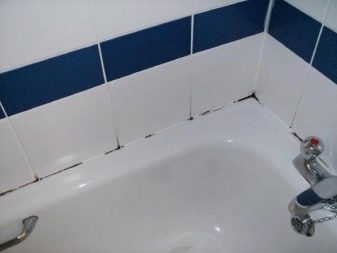
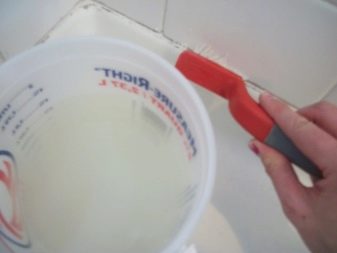
What do I do if mold comes back?
It happens that after some time after removal, mold reappears in the same place, and even thorough treatment of the problem area with effective remedies does not help. In this case, the hotbed of spreading should be looked for not on the surface of the silicone sealant, but under it. If this is the case, the layer of sealant will have to be removed to get to the center.
- The stale silicone sealant can only be removed mechanically. So arm yourself with a small knife and start cutting the silicone sealant along the top and bottom edge of the seam.
- After making the cuts, pick up the silicone layer at one end and pull the cured sealant out of the seam. The old silicone sealant is best discarded immediately, since mold spores are firmly established in its structure.
- Inside the seam, you are likely to find mold, small debris and other crap. All this must be thoroughly cleaned with the same knife.
- Now you need to disinfect the cleaned area to be sure that mold will not reappear. One of the most effective tools is isopropyl alcohol. Pour it into the seam and leave it for 20-30 minutes.
- After that, blot the seam with a dry rag and leave it for 24 hours until it dries completely. During this time, the bath should not be used.
- The dry surface should be reapplied with silicone sealant. Try to choose a quality sanitary sealant for the bathroom, containing additives that prevent mold.
- Insert the tube with sealant into a special gun, cut the spout at an appropriate angle and distribute the product evenly over the entire joint.
- In order for the silicone to dry completely, you need to wait another day.

Folk remedies
In the fight against mold, you can also use folk recipes, many of which are much more effective than expensive store remedies. Some of the many ways that housewives use to eliminate mold in the bathroom are presented below.
Dissolve sodium tetraborate (popularly called "borax") in water at a ratio of 1 cup of the drug to 2 ½ liters of water. Soak an old toothbrush in this solution and thoroughly wipe the mold-affected area. Then collect the rest of the solution with a clean, dry cloth. There is no need to wash off the solution, as it forms a protective layer against mold.
White table vinegar is an effective and, most importantly, affordable remedy against mold in the bathroom. It is enough to sprinkle the mold-covered places with undiluted vinegar through a sprayer, and after 60 minutes, wash off with a sponge moistened with water. If necessary, repeat the procedure the next day. Vinegar has a pungent smell and its vapors can have a negative effect on your well-being, so be sure to ventilate the bathroom every time after this procedure.
You probably have hydrogen peroxide in your medicine cabinet. This drug is indispensable not only for treating wounds, but also for sterilizing mold-affected areas. Hydropyrite tablets should be diluted in water according to the instructions, and the prepared solution should be applied undiluted. It is better to work with gloves, as prolonged contact with hydrogen peroxide can damage the skin of the hands. There is no need to wash off the solution, after a few minutes just blot the treated surface with a dry sponge or cloth.
Ordinary baking soda is also an excellent way to eliminate mold. It is absolutely safe for humans, costs pennies and can be found in everyone's home. To make the cleaner, you need to stir a quarter teaspoon of baking soda in 250 ml of warm water. Rub the resulting solution into the area with mold with a stiff brush, then rinse. Consolidate the effect by repeating the operation one more time.
Essential oils are also quite effective in the fight against mold. Tea tree oil, known not only for its pleasant aroma, but also for its good antiseptic properties, is especially effective. One teaspoon of essential oil should be diluted in a glass of warm water and treat the problem area with the solution. It is not necessary to wash it off. After applying the solution, the intense smell of tea tree essential oil will remain for some time, but after a couple of days it will disappear.
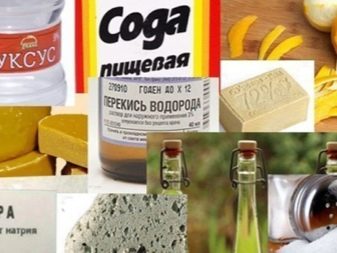
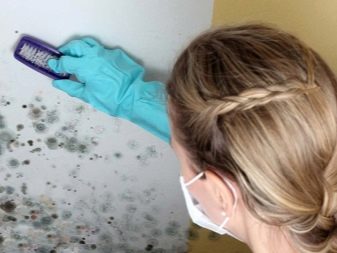
Prevention
After removing mold from silicone sealant, you need to take all precautions so that it does not appear again. A set of preventive procedures includes:
- Equipping the ventilation system. Keep in mind that even the most powerful ventilation system will not do the job if you do not provide a constant flow of air into the bathroom (for example, through a gap in the door).
- Sealing of sanitary equipment in the bathroom. It is necessary to eliminate all sources of high humidity, including a dripping faucet and condensation on the cistern of the toilet.
- Insulation of the walls. If any of the walls of the room freezes during the winter, you need to provide it with additional waterproofing.
- Fixing cracks in the walls, floor and ceiling. Mold spores can enter the bathroom from neighboring apartments even through microscopic gaps.
